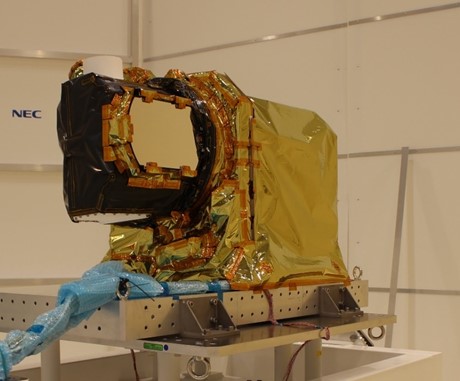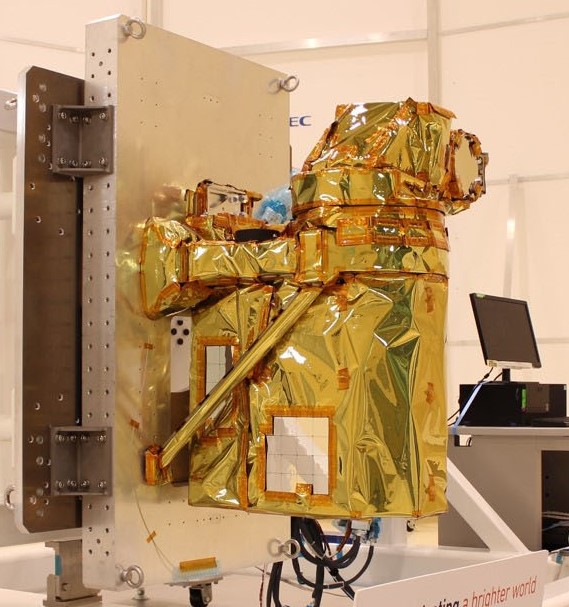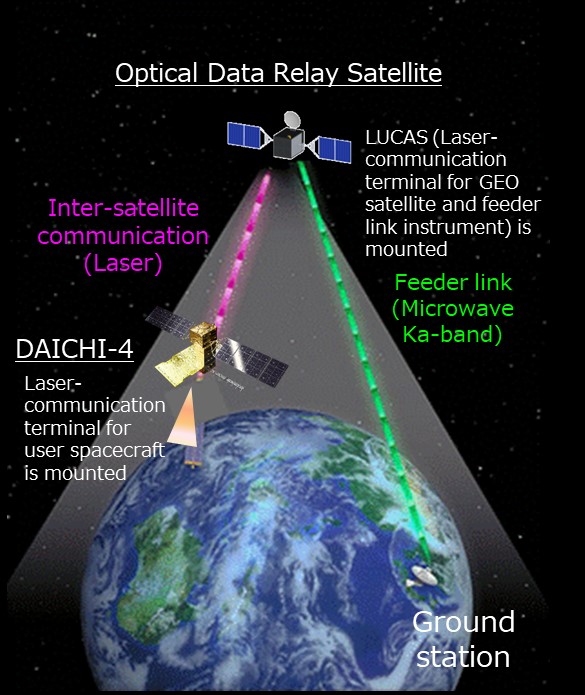Successful achievement of the world's fastest optical inter-satellite communication at a speed of 1.8 Gbps between the Laser Utilizing Communication System (LUCAS) and the Advanced Land Observing Satellite-4 “DAICHI-4” (ALOS-4)
October 8, 2024 (JST)
Japan Aerospace Exploration Agency
The Japan Aerospace Exploration Agency (JAXA) successfully achieved the optical inter-satellite communication at a speed of 1.8 Gbps*1 between the Laser Utilizing Communication System (LUCAS)*2 aboard the Optical Data Relay Satellite*3 and the Advanced Land Observing Satellite-4 “DAICHI-4” (ALOS-4)*4.
Since July 4, JAXA has been conducting the initial functional verification operations of “DAICHI-4” to verify on-orbit operations of various onboard instruments. As part of this verification, a test to link “DAICHI-4” to LUCAS began on August 20. By establishing bidirectional acquisition and tracking between the optical inter-satellite communication instrument (Optical Leo Laser Communication Terminal:OLLCT) on board “DAICHI-4” and LUCAS on board the Optical Data Relay Satellite, which are about 40,000 km apart, command was successfully transmitted to “DAICHI-4”, and telemetry was successfully retrieved from “DAICHI-4”. This confirmed that the data transmitted from “DAICHI-4” reached LUCAS at the world's fastest communication speed of “1.8 Gbps” (communication wavelength band of 1.5 μm).
This is the world’s first successful optical inter-satellite communication between geostationary orbit and low Earth orbit at a communication speed of “1.8 Gbps” in the 1.5 μm wavelength band. It is a speed 7.5 times faster than the “240 Mbps” transmission rate of the preceding Data Relay Test Satellite “KODAMA” (DRTS)*5. This wavelength band is a common wavelength used in terrestrial fiber optical communication networks and is expected to be used in space in the future due to its high performance.
With this success in communicating between the low orbit satellite and LUCAS, an increase in communication time to about 9 hours from the typical 1 hour per day for ordinary communications between low orbit satellites and ground stations can be realized, thanks to LUCAS relaying the geostationary orbit satellite.
This enables real-time transmission of data acquired in areas where Earth observation satellites in the low orbit cannot directly communicate with ground stations, via the geostationary orbit satellite to the ground. Similarly, during emergencies, commands can quickly be sent from the ground to satellites via LUCAS by relaying the geostationary satellite, and observation imagery can be acquired promptly.
JAXA will continue demonstrations to assess how differences in the distance between satellites and their positional relationship affect communication quality using LUCAS and “DAICHI-4” with the aim of practical use.
Additionally, plans are in place to conduct demonstrations of transmitting observation data and experimental data from spacecraft orbiting at medium to low altitudes (200 - 1,000 km), such as “Kibo*6” and others in addition to “DAICHI-4”, by relaying via LUCAS to ground stations.
JAXA conveys a deep appreciation for the cooperation and support of everyone involved in this demonstration of the optical inter-satellite communication, including the government agencies, the prime contractor, NEC Corporation, and all the companies and organizations involved in the development, manufacture and operation of this system.
*1
Same speed as the European Data Relay System (EDRS) (provided that the wavelength is 1.064 μm).
1.5μm is the same wavelength used in terrestrial optical fiber networks and it is expected to become mainstream in the future, with the perspective of using the most advanced devices and technology in this field.
*2
LUCAS: Laser Utilizing Communication System
(A communication system consisting of the laser-communication terminal onboard the Optical Data Relay Satellite (Figure 1), the laser-communication terminal onboard “DAICHI-4” etc. (Figure 2), and the optical ground system.)
*3
Launched by the H-IIA Lauch Vehicle No. 43 on November 29, 2020
*4
Launched by the third H3 Launch Vehicle on July 1, 2024
*5
“KODAMA”: Launched by the third H-IIA Launch Vehicle on September 10, 2002, and completed its operations on August 5, 2017.
(Web page)https://www.satnavi.jaxa.jp/ja/project/drts/(Japanese Only)
*6
Japanese Experiment Module of the International Space Station (ISS)
Further updates on LUCAS will be posted on the JAXA website.
"Optical Satellite Communication System (LUCAS)" in JAXA website (Japanese Only)

©JAXA
Figure 1. Laser-communication terminal aboard the Optical Data Relay Satellite.

©JAXA
Figure 2. Laser-communication terminal aboard “DAICHI-4”

Figure 3. Optical Data Relay System
Observation data obtained by “DAICHI-4” is transmitted to the ground station via the Optical Data Relay Satellite. Laser communication is used between “DAICHI-4” and the Optical Data Relay Satellite. Microwave (Ka-band) is used between the Optical Data Relay Satellite and the ground station (feeder link).